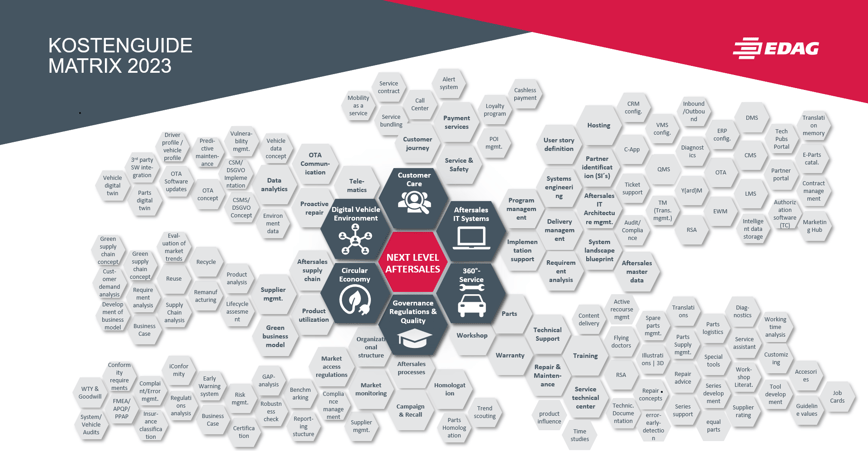Recalls, guarantee and warranty cases are a problem for vehicle manufacturers, because they can result in enormous costs. How to carry out repairs as efficiently as possible is not the only critical question. How to permanently reduce the failure rate also needs attention. EDAG's cost guide highlights the most important aspects of such aftersales costs and shows ways of getting to the root of the problem.
Latest figures show that 2021 was an expensive year for vehicle manufacturers: Some 3.4 million vehicles had to be recalled for repairs, an increase of around twelve percent compared to the previous year. In fact, far from being some kind of unfortunate blip, this development was part of the "new normal" in the modern auto world. The ten years from 2012 to 2021 saw an enormous increase in the number of recalls: from 162 to 575 a year, peaking at 628 in 2019. Though the number of recalls says very little about the number of vehicles affected. In 2021, for instance, driver assistance systems accounted for just 20 recalls (equivalent to 3.5 percent), but some 750,000 cases requiring repair (equivalent to 22 percent).
So where is the problem?
There are many reasons for this development. Part of the problem is the use of new technologies that have not yet reached the same level of maturity as tried-and-tested components. The use of more software - such as the previously mentioned assistance systems (lane departure warning systems, collision warning assistants, etc.) - can be mentioned here. Although these systems often make driving safer, sometimes also easier, their technical complexity does compromise reliability. Another point are shorter product cycles. Due to the fact that competitive pressure is high and manufacturers want to bring their innovations to the consumers as quickly as possible, more and more new models and updated variants are coming onto the market at shorter and shorter intervals. This does, however, this also shorten development and test times, so increasing the risk of defective parts and developments not being recognized in time.
And last but not least, structural market developments are possibly also a driver. On the one hand, because the OEMs pass on the competitive and cost pressure to the suppliers - who, for economic reasons, then reduce quality standards to the lowest possible levels. And on the other, because, especially in the field of drive electrification, many new players who simply do not have the experience are entering the market.
Examination of the life cycle
In the search for ways to reduce costs, different strategies lead to success. One approach is to examine the individual phases of a vehicle's life cycle for specific potential for improvement, which would lead to fewer breakdowns and so reduce the costs involved.
Once the vehicle is in the repair shop, a rapid and reliable error diagnosis system is called for. A wide database can significantly improve the quality of statements made. Including additional information taken from the vehicle, about the vehicle's history and from innovative technical diagnostic methods also enables AI applications to be used. In a service situation, this leads to better results and also makes preventive maintenance possible. Flying doctors concepts, identical parts, modular and platform strategies and the use of digital job cards to optimize service staff management and repair shop processes all help to improve efficiency. A key factor, especially at a time when the shortage of skilled labor is increasing!
Further steps towards more efficient repairs and maintenance include, for example, informative technical documentation that covers all product variants available and is both user-friendly and useful, the creation of intelligent repair concepts conceived during the development phase, and repair support which not only benefits the customer, but also provides the vehicle manufacturer with valuable feedback. Responsibility for the provision of time studies and present value analyses and for processes that ensure that the incoming feedback is heard and taken into account in product development also lies here. In the process, we actively support the process by offering dealers support.
The way we design these service measures can have an influence on the reduction of the total cost of ownership (TCO). For vehicle manufacturers, the TCO is a key factor, as not only is it used by fleet customers for investment decisions, but it also serves as a basis for insurance companies for type class classification. And just as importantly, they offer every customer an indication of the maintenance costs they can expect.
It is also essential to make full use of every available opportunity to reduce warranty and goodwill cases. There is often still potential for optimization in the early detection of errors and the management of claims for damages, campaigns and recalls. A detailed supplier rating can help to improve the quality of purchased components and assemblies, and therefore reduce failure rates.

Using digitalisation
Remote services, first and foremost the improvement of software components by means of remote maintenance (over-the-air update, OTA), are enjoying growing popularity. However, its use needs to be well planned and protection against cyber attacks must be given top priority.
The reason for this is that potential hacker attacks on the company must be handled as financial risks. Sound vulnerability management and the planning and implementation of cyber security and data protection are therefore mandatory. The theft of intellectual property, the encryption of company data by blackmail Trojans, which is sometimes not even reversed after high ransom payments have been made, production downtime, damages and penalties in the event of loss of customer data, but also a loss of image or damage to the brand image - the economic consequences of security deficiencies are incalculable.
The use of digital twins, however, promises efficiency gains in day-to-day business. This concept can help with vehicle health checks and with the tool inventory in the workshop or the fulfillment of legal requirements relating to the individual component – from documentation of the supply chain to the declaration of pollutants and the disposal process.
Modernizing the IT landscape
Finally, the existing IT systems in the company are also a possible cost driver. Modern tools which simplify processes, open up automation potential and are easier to service can help to quickly amortize investment costs. Requirements management, assistance with IT implementation and an efficient supplier management system are the most important points here.
Conclusion
The cost structures are as complex as the aftersales services and processes in the automotive industry are diverse. With its wide range of skills and in-depth experience-based knowledge, an external partner like EDAG can offer valuable support in realizing efficiency potential. There are many different opportunities for working together in a profitable way. There are a number of roles that EDAG can take on:
- Innovator for object-oriented fields of action, possible solutions and strategic topics
- Engineering partner for processes and system integration
- A supportive role in the performance of product-related services, in the sense of an extended workbench during periods of peak staff utilization
- 100 percent service provider, as the general contractor for complete packages, for example, but also for handling elements of work packages.
Details can be obtained from Daniel Heil, Aftersales Team Leader at EDAG Engineering. The "EDAG Cost Guide" contains extensive suggestions and a detailed summary of the various services offered by EDAG in this field. Download the PDF here.






